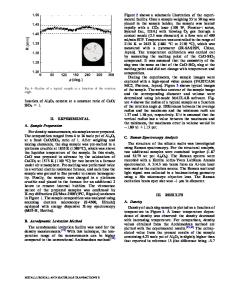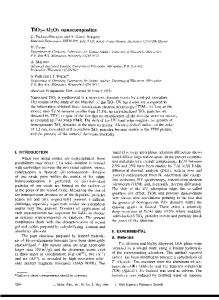Some observations on the draining of CaO-SiO 2 -Al 2 O 3 slag bubble films
- PDF / 366,837 Bytes
- 11 Pages / 612 x 792 pts (letter) Page_size
- 77 Downloads / 347 Views
I. INTRODUCTION
INTEREST in slag-foaming phenomena has been reinvigorated with the development of new intensive smelting processes. For instance, in bath smelting or electric are furnace steelmaking, slag foams provide a large surface area for multiphase reactions to occur, leading to improved process kinetics, heat transfer, and energy efficiency. A foam comprises a gas, being the dispersed phase, and a liquid (slag), being the continuous phase. Often the slag foam layer is composed of two regions where the structure of the foam can differ, i.e., a dense foam layer in the lower region and a less-dense (foamy) region in the upper part of the vessel. Within the lower region, the bubble lifetimes can be described as transient, as they jostle together as an assembly of thick-filmed spheres (first termed Kugelschaum by Manegold[1]). Bubbles present in the upper foamy layer are metastable, i.e., the films are well drained and quasipolyhedral in shape (Polyederschaum), as the thin films separating adjacent bubbles become planar (or slightly curved) and are of practically uniform thickness.[2] Sharma and Ruckenstein[3] have acknowledged that the surface properties of such well-drained bubble films can strongly influence the coalescence and rupture time in aqueous systems. In hightemperature systems, the rate of entrainment, or escape of gas bubbles from a foam, is expected to be strongly influenced by the stability (lifetime) of the films in the upper foam layer, i.e., the extent and rate of drainage of these films will ultimately determine the steady-state foam height achieved. Drainage of liquid from bubble films is controlled by two very important forces. The first and more obvious is gravity, while the second is termed plateau border suction.[4] This important latter mechanism is due to the intersection of strongly curved bubble films, where the pressure inside them C. NEXHIP, Research Scientist, S. SUN, Principal Research Scientist, and S. JAHANSHAHI, Research Manager and Senior Principal Research Scientist, are with the G.K. Williams Cooperative Research Centre for Extractive Metallurgy, CSIRO Minerals, Victoria 3169, Australia. This article is based on a presentation made in the “Geoffrey Belton Memorial Symposium,” held in January 2000, in Sydney, Australia, under the joint sponsorship of ISS and TMS. METALLURGICAL AND MATERIALS TRANSACTIONS B
(P9) is less when compared to the more planar parts of their central lamellae (P8). This pressure differential (DP 5 P8 2 P9) exercises a suction force on the liquid within the films toward the plateau borders and has been found to dominate the drainage of films within aqueous systems.[5] An exception to this is in very thin films, where their thickness (d) is less than 0.1 mm, i.e., where van der Waal’s or electrical-doublelayer interactions can become significant.[6] The stability of foams has previously been measured using the inert gas injection technique, originally developed by Bikerman[7,8] for studies on aqueous systems. Others have previously adopted the technique
Data Loading...











